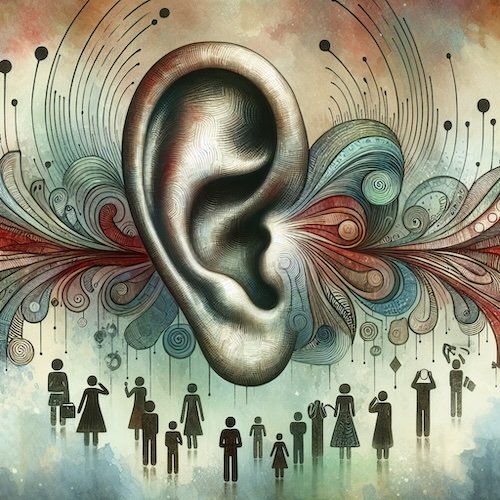Listen Up and Listen Well: The Art of Listening
 The Art of Listening
The Art of ListeningDoes anybody really listen anymore?
As a personal historian, writer and teacher I am constantly engaged in conversations, life lessons and talks about life. But I am concerned these days how so few people seem to be really listening.
Granted, there is a lot of noise in our lives. We are bombarded with messages from sunup to sundown – and beyond!
Everybody talks, but who really listens? And if they are listening, how actively are they in this process of communication? I am worried that the art of listening has become a lost art.
Listening is an art, a skill that goes beyond mere hearing.
Have you ever wondered why some people can effortlessly engage an audience with their stories? It's because they've mastered "the art of listening," both to others and themselves.
When we talk about sharing life stories, understanding and truly hearing what someone means, what their real message is, can create a bridge to the heart of others.
What is the art of listening?
If listening is an art then just what does that mean? Experts refer to things like active listening. This implies that listening is not a passive process. Good listeners are actively listening, not simply “hearing”.
If you are going to be a good listener then it helps to understand the 4 elements of listening: receiving, understanding, evaluating, and responding.
When you engage with these four stages the person talking to you knows you're really there with them. Understanding, evaluating and responding require some work on the part of the listener. Did you understand what was said? Can you repeat it back to the speaker in an empathetic and sincere manner?
Body language cues like good eye contact and nodding your head help show that you are receiving the message.
What are some of the hindrances to this communication?
People get distracted. I learned this firsthand from teaching elementary school children for over a decade.
Kids in school like to talk. They can be very social, especially the fifth grade age group of ten and eleven year olds that I taught for several years. Holding their attention and engaging them in true collaborative conversation was very challenging.
Very challenging!
One of my favorite teacher tricks was to point out that the words silent and listen have the same letters.
There is a whole lot more to listening than being silent. How we listen makes a difference in what we hear and the meaning of the message.
Another technique by teachers and speakers is to teach SLANT. It is an acronym for “Sit up, Lean in, Nod, and Track the speaker”. Good stuff.
Active listening involves more than hearing. We need to look at the speaker, listen closely and listen with our whole being. Try it and you might find that you are listening with something very special – your heart.
Wait Your Turn
Before responding to the speaker, think about your response. Sometimes we are tempted to jump in too soon and add our own comments and opinions. Feedback can be good, but first show that you are really hearing what is being said.
What does being an engaged and active listener look like?
- It’s in the nods of understanding, the reflection of someone’s feelings back to them.
- It's in asking open-ended questions that encourage deeper reflections.
How can you bring this into your storytelling? Try weaving these reflections back into your narrative, showing your audience that you hear their emotions and thoughts too.
Reflective listening doesn't just benefit your storytelling.
It enhances your life as a whole, allowing you to forge deeper connections with the world around you. When others recognize that you truly understand them, mutual respect flourishes, and a new level of communication begins.
Personal history and memoir writing are matters of the heart. They deserve to be heard.
They deserve to be heard on a heartfelt level and that means listening as an art form. In other words, the art of listening.